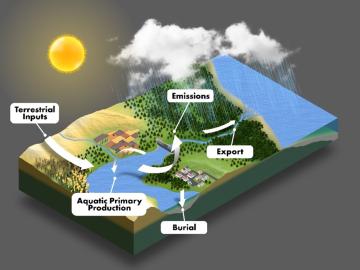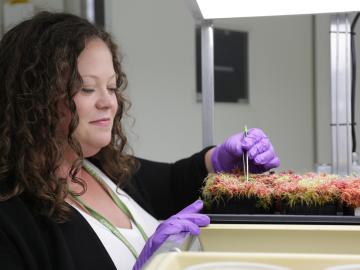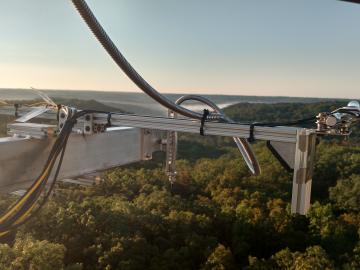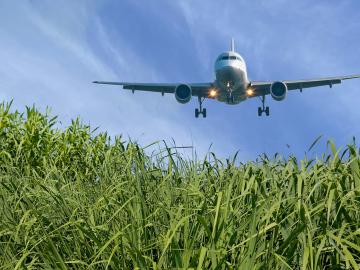
Filter News
Area of Research
- (-) Biology and Environment (67)
- Advanced Manufacturing (7)
- Biological Systems (1)
- Biology and Soft Matter (1)
- Computational Biology (2)
- Computational Engineering (3)
- Computer Science (9)
- Electricity and Smart Grid (3)
- Energy Science (104)
- Fuel Cycle Science and Technology (1)
- Functional Materials for Energy (1)
- Fusion and Fission (35)
- Fusion Energy (12)
- Isotope Development and Production (1)
- Isotopes (12)
- Materials (103)
- Materials Characterization (1)
- Materials for Computing (15)
- Materials Under Extremes (1)
- Mathematics (1)
- National Security (32)
- Neutron Science (43)
- Nuclear Science and Technology (40)
- Nuclear Systems Modeling, Simulation and Validation (2)
- Quantum information Science (1)
- Sensors and Controls (2)
- Supercomputing (79)
- Transportation Systems (1)
News Topics
- (-) Advanced Reactors (1)
- (-) Artificial Intelligence (9)
- (-) Biomedical (16)
- (-) Grid (3)
- (-) Materials Science (6)
- (-) Nuclear Energy (1)
- (-) Security (2)
- 3-D Printing/Advanced Manufacturing (11)
- Big Data (10)
- Bioenergy (46)
- Biology (74)
- Biotechnology (14)
- Buildings (2)
- Chemical Sciences (12)
- Clean Water (11)
- Composites (5)
- Computer Science (19)
- Coronavirus (13)
- Critical Materials (1)
- Cybersecurity (1)
- Energy Storage (7)
- Environment (91)
- Exascale Computing (4)
- Frontier (3)
- Fusion (1)
- High-Performance Computing (20)
- Hydropower (8)
- Isotopes (2)
- Machine Learning (9)
- Materials (12)
- Mathematics (4)
- Mercury (7)
- Microscopy (10)
- Molten Salt (1)
- Nanotechnology (7)
- National Security (3)
- Neutron Science (4)
- Partnerships (6)
- Physics (2)
- Polymers (2)
- Simulation (15)
- Summit (10)
- Transportation (3)
Media Contacts

Global carbon emissions from inland waters such as lakes, rivers, streams and ponds are being undercounted by about 13% and will likely continue to rise given climate events and land use changes, ORNL scientists found.

Chemical and environmental engineer Samarthya Bhagia is focused on achieving carbon neutrality and a circular economy by designing new plant-based materials for a range of applications from energy storage devices and sensors to environmentally friendly bioplastics.

Science has taken Melanie Mayes from Tennessee to the tropics, studying some of the most important ecosystems in the world.

As the United States moves toward more sustainable and renewable sources of energy, hydropower is expected to play a pivotal role in integrating more intermittent renewables like wind and solar to the electricity grid

Microorganisms may provide hope that peatlands can withstand hotter temperatures in a changing climate.

Scientists develop environmental justice lens to identify neighborhoods vulnerable to climate change
A new capability to identify urban neighborhoods, down to the block and building level, that are most vulnerable to climate change could help ensure that mitigation and resilience programs reach the people who need them the most.

Technology developed at ORNL to monitor plant productivity and health at wide scales has been licensed to Logan, Utah-based instrumentation firm Campbell Scientific Inc.

ORNL scientists will present new technologies available for licensing during the annual Technology Innovation Showcase. The event is 9 a.m. to 3 p.m. Thursday, June 16, at the Manufacturing Demonstration Facility at ORNL’s Hardin Valley campus.

The rapid pace of global climate change has added urgency to developing technologies that reduce the carbon footprint of transportation technologies, especially in sectors that are difficult to electrify.

Surrounded by the mountains of landlocked Tennessee, Oak Ridge National Laboratory’s Teri O’Meara is focused on understanding the future of the vitally important ecosystems lining the nation’s coasts.


